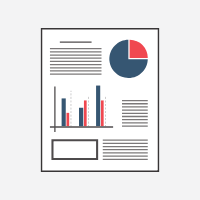Quick Guide: The Current Ratio
Calculating financial ratios and metrics can be a time-consuming project.
Our goal at DiscoverCI is to provide the tools and resources you need to spend less time finding and calculating data, and more time analyzing data.
The current ratio calculator is a useful tool to help evaluate a company’s liquidity. But there are a few key points you should know to effectively use the ratio in your analysis.
We’ll cover a few of them below, including:
- How to calculate the current ratio,
- What does it measure,
- What is a good current ratio, and
- An example to further enhance your understanding of the ratio.
By the end of this article you'll have everything you need to analyze a company’s current liquidity.
What is the formula for the current ratio
The ratio is calculated by taking a company’s current assets, and dividing that by the company’s current liabilities:
Current Ratio = Current Assets / Current Liabilities
What does the current ratio measure
This ratio is part of a larger family of financial ratios known as liquidity ratios. These ratios measure a company’s ability to meet its obligations using its short term assets.
For more details on these ratios, check out our deep dive into liquidity ratios.
The current ratio measures a company’s current assets relative to its current liabilities. The calculated ratio is the number of times a company could pay off its current debts with its current assets.
What is a good current ratio
Analyzing whether a company's ratio is strong depends on various factors.
These factors include:
- The nature of the company’s operations,
- The trend of the company’s ratio over time, and
- How the company measures up to its peer group and industry competitors.
In most cases, the higher the ratio, the better. A higher ratio indicates a company is well positioned to pay off its short-term debts.
A company with a ratio that is higher than 1 may be worth looking into further, but generally a ratio closer to 1.5 or above is best.
Anything below 1 indicates there could be trouble up ahead. A ratio below 1 tells you that the company’s current assets are less than their current liabilities, which is not good!
Those are only general benchmarks.
Analyzing financial ratios can be difficult. Knowing where to start and how to complete your analysis prevents some people from ever getting started.
If you're interested in learning more about financial ratio analysis, we've covered this framework in greater detail here.
An example of the current ratio
Let’s take a look at a quick example:
Apple Inc. (AAPL) reported current assets of $128,645,000 (in thousands, $USD) and current liabilities of $100,814,000 (in thousands, $USD) as of September 30, 2017.
Using the formula we outlined above, the company’s ratio pencils out to:
1.28 = $128,645,000 / $100,814,000
Not bad!
In Summary
Strong companies manage their cash flows and net working capital effectively.
Evaluating a company’s current ratio will give you a good idea of whether a company is well positioned to pay off their short term liabilities using their short term assets.
Alright!
You have the current ratio calculator, the current ratio formula and your brainpower. Everything you need to analyze a company’s A/R turnover ratio!
But don’t stop there if you’re looking to invest in companies with impressive current ratios.
Use our customizable stock screener to find undervalued companies with enough short-term assets to cover their upcoming debts.







